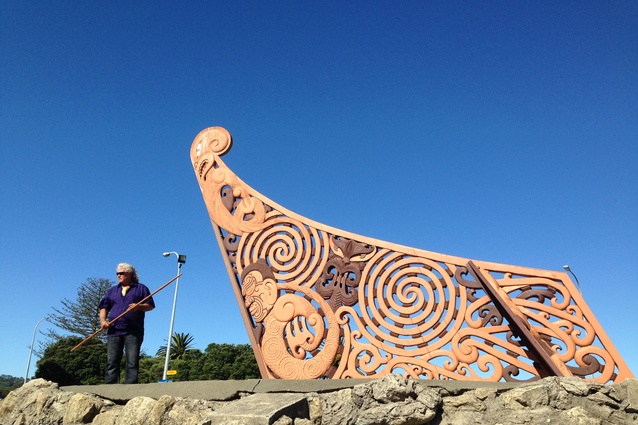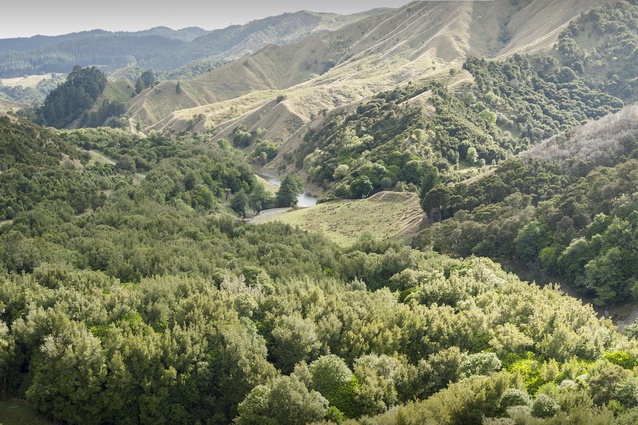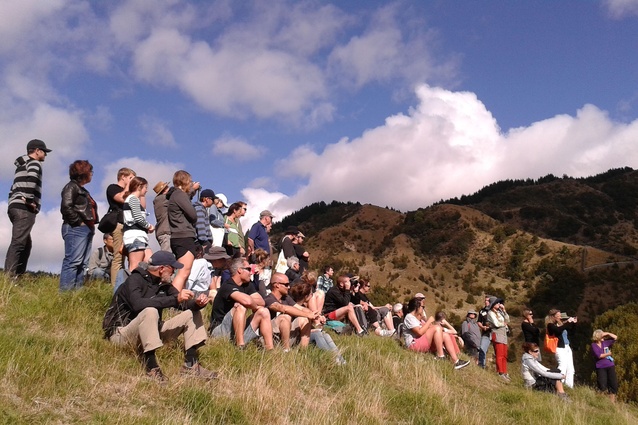Footsteps in the sand
To create the first footsteps and explore new territory requires courage, vision and faith. The more people that travel a path, the easier it becomes to follow. Captain James Cook had ‘footsteps’ in the form of instructions and a partial map, which Abel Tasman had drawn 120 years before, of what was thought to be the coast of the great southern continent. Tasman followed the Spanish and the great Polynesian canoes. The canoes had the kūaka (godwits) and the stars.
Almost 245 years after Cook stepped ashore at Tairawhiti, a 70-strong group of inquisitive landscape architects arrived on the site as part of the 2014 NZILA Conference. We all travelled to the place of the rising sun, where we found the clear and recent footsteps of people like Thomas Woltz and Dame Anne Salmond.
Conference delegates were warmly greeted by the people of Ngai Tamanuhiri at Muriwai Marae, which had a powerful energy and a sense of community and oneness, making it a very grounding starting point to our journey.
General manager of Ngai Tamanuhiri Whanui Trust, Richard Brooking, explained the collaboration involved in achieving the visions of his iwi, working within a well-organised unit of strong and inspirational stakeholders to ensure long-term custodianship of the land. It was interesting to note the transformed relationship between the iwi and the owners of Orongo (Nick’s Head Station). From an initial stance of conflict over the sale of Orongo to foreign owners, the iwi is now actively engaged with the management of the farm, ensuring appropriate stewardship and care for their land.
Orongo became the most anticipated field trip of the conference. Landscape architect Thomas Woltz greeted delegates and introduced farm manager Kim Dodgshun and his US-based colleague Breck Gastinger. After an introduction to its history, Woltz walked the group through the diverse spaces that now make up Orongo, beginning with the promenade to the urupa, sharing stories of the project team’s journey with this ancient and sacred land.
Some kilometers later, the group descended a broad sweeping corner to arrive at Orongo Wetland. It was a surreal landscape of massive scale, teeming with native flora and fauna that felt pre-historic. As we reached the pristine white sand beach that leads north to Te Kuri a Paoa, few could resist the cool, soothing waters of the Pacific Ocean.
Woltz emphasised the team effort required for this colossal project, offering most of the credit to his colleagues. It was refreshing to see a deeply passionate designer explain his work in such a humble manner. As a designer, he has exposed the raw underlying power of the landscape as a carver exposes the beauty within a piece of wood.
Next stop was Waiohika, the home of Rhythm & Vines. It took some time, a number of bottles of wine, a continuous supply of hors d’oeuvres, and a presentation from event and festival director Chris Gillies to begin to understand the energy of the landscape, which attracts thousands of young people each new year.
It was interesting to see the response from young festival-goers who stated “the landscape, the music, the people” when asked what made it special. A sunrise breakfast at Wainui Beach marked the beginning of day two, before the group travelled north to Longbush Ecosanctuary. Hosts Dame Anne and Jeremy Salmond, introduced the small, talented team who have helped them on their journey to transform a steep, rugged farm into an ecological haven, a beautiful holiday home, and a community, complete with a welcome shelter/outdoor classroom.
While Longbush Ecosanctuary and Orongo have achieved (thanks to the efforts of talented ecologist Steve Sawyer) large-scale habitat restoration balanced with cultural sensitivity within productive landscapes, it was evident they got there in different ways. Dame Anne Salmond has created a place from the strong vision, passion and collaboration of the people involved. While at Orongo Station you felt like a welcome visitor, at Longbush you felt as if you were welcomed home.
The conference concluded with Eastland Community Trust members Richard Brooking and Joe Martin telling delegates of the first encounters between Maori and European settlers, while looking at and standing in the places around the Turanganui River where these historic events took place. Landscape architect Catherine Hamilton and sculptor Te Aturangi Nepia-Clamp then explained how these special places are being recognised and celebrated through art, sculpture, and urban design.
For many delegates, this conference was about rising to the challenge of finding, expressing and celebrating the identity of small towns and regions in extraordinary and memorable ways. Every speaker had shaped, and had been shaped by, the land with which they worked. We were stunned with the beauty and power of this landscape, its ecological systems, and its imbedded history.
Our profession makes a unique contribution to communities, with the capacity to transform ecosystems, places and people.
The projects and places we visited displayed an honest collaboration between cultures, communities, professions and individuals. This approach will continue to guide the recognition of Tairawhiti significant arrival sites, including preparations for the 250th commemoration of the landing of Captain James Cook in 2019.












